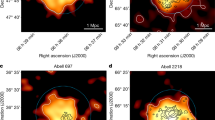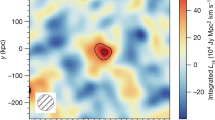Abstract
THE large energies and short time-scales characteristic of the quasi-stellar radio sources present major problems for their interpretation. The total power emitted by 3C 48 is estimated to be 2 × 1046 ergs/sec1. The presence of nebulosity around 3C 48 (ref. 1) and 3C 273 (ref. 2) suggests lifetimes of at least 5 × 1012 sec, so that the emitted energy exceeds 1059 ergs. If a major part of this energy is in the form of synchrotron radiation, this is a lower limit to the energy contained in relativistic electrons. Similar lower limits follow for the relativistic particle energies in bright radio galaxies, even if the proton component is small3. The appearance of the nebulosity and the ratio of radius to velocity suggest that the lifetime of these objects is not much greater than 106 years. Both sources are observed to vary in optical brightness over a period of years4,5, and there is some evidence that 3C 48 varies over a period of weeks as well1.
This is a preview of subscription content, access via your institution
Access options
Subscribe to this journal
Receive 51 print issues and online access
$199.00 per year
only $3.90 per issue
Buy this article
- Purchase on Springer Link
- Instant access to full article PDF
Prices may be subject to local taxes which are calculated during checkout
Similar content being viewed by others
References
Matthews, T. A., and Sandage, A. R., Astrophys. J., 138, 30 (1963).
Schmidt, M., Nature, 197, 1040 (1963).
Maltby, P., Matthews, T. A., and Moffet, A. T., Astrophys. J., 137, 153 (1963).
Smith, H. J., and Hoffleit, D., Astro. J., 68, 292 (1963).
Sandage, A. R., Astrophys. J., 139, 416 (1964).
Shklovsky, I. S., Soviet Astronomy, 4, 885 (1960).
Burbidge, G. R., Nature, 190, 1053 (1960).
Cameron, A. G. W., Nature, 194, 963 (1962).
Ginzberg, V. L., Soviet Astronomy, 5, 282 (1961).
Shklovsky, I. S., Soviet Astronomy, 6, 465 (1963).
Hoyle, F., and Fowler, W. A., Nature, 197, 533 (1963).
Hunter, C., Astrophys. J., 136, 594 (1962).
Schmidt, M., Astrophys. J., 129, 243 (1959).
de Vaucouleurs, G., Handb. Phys., 53, 275 (1959).
Greenstein, J. L., lectures at the Institute for Advanced Study, Princeton, N.J. (February 1964).
Author information
Authors and Affiliations
Rights and permissions
About this article
Cite this article
FIELD, G. Quasi-stellar Radio Sources as Spherical Galaxies in the Process of Formation. Nature 202, 786–787 (1964). https://doi.org/10.1038/202786a0
Issue Date:
DOI: https://doi.org/10.1038/202786a0
Comments
By submitting a comment you agree to abide by our Terms and Community Guidelines. If you find something abusive or that does not comply with our terms or guidelines please flag it as inappropriate.



